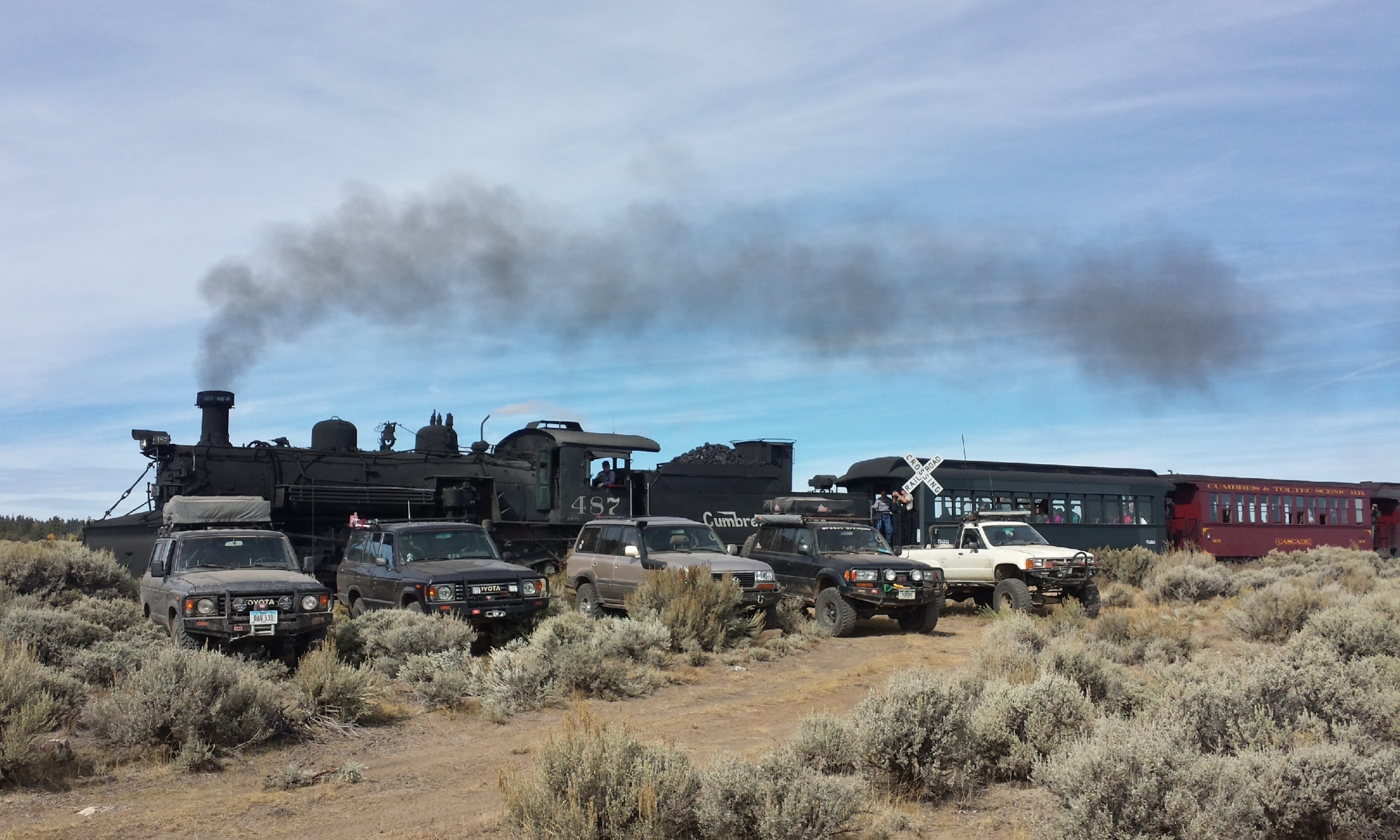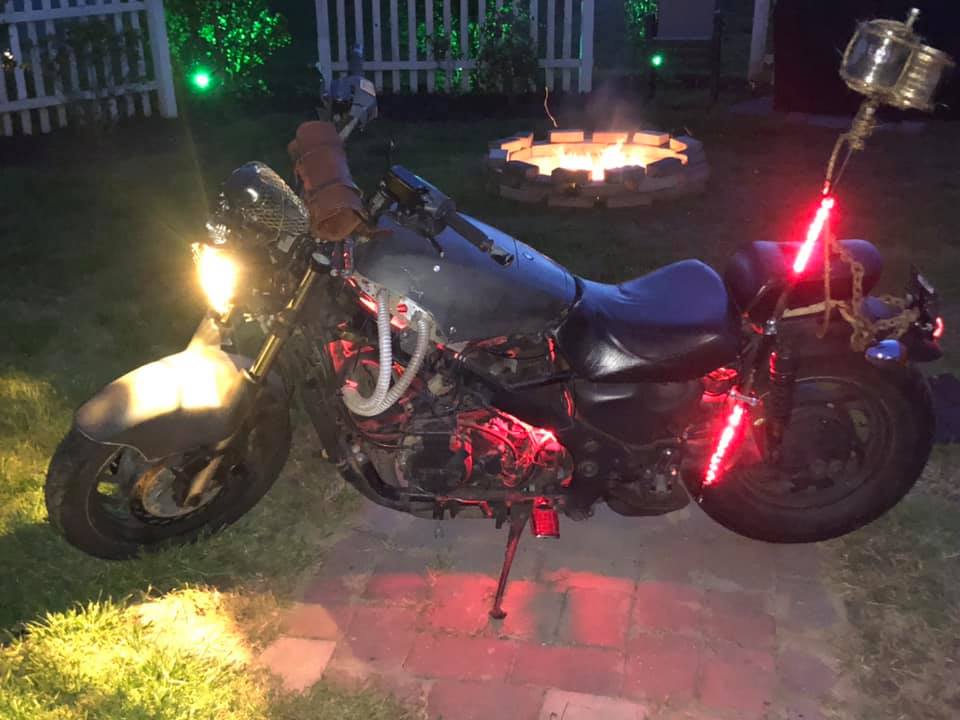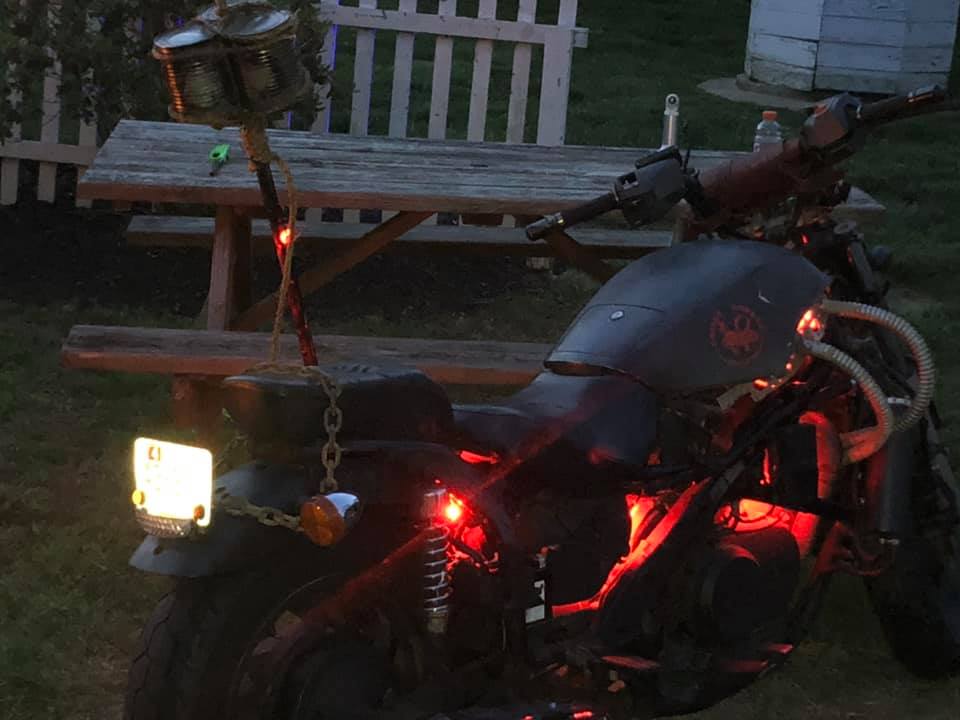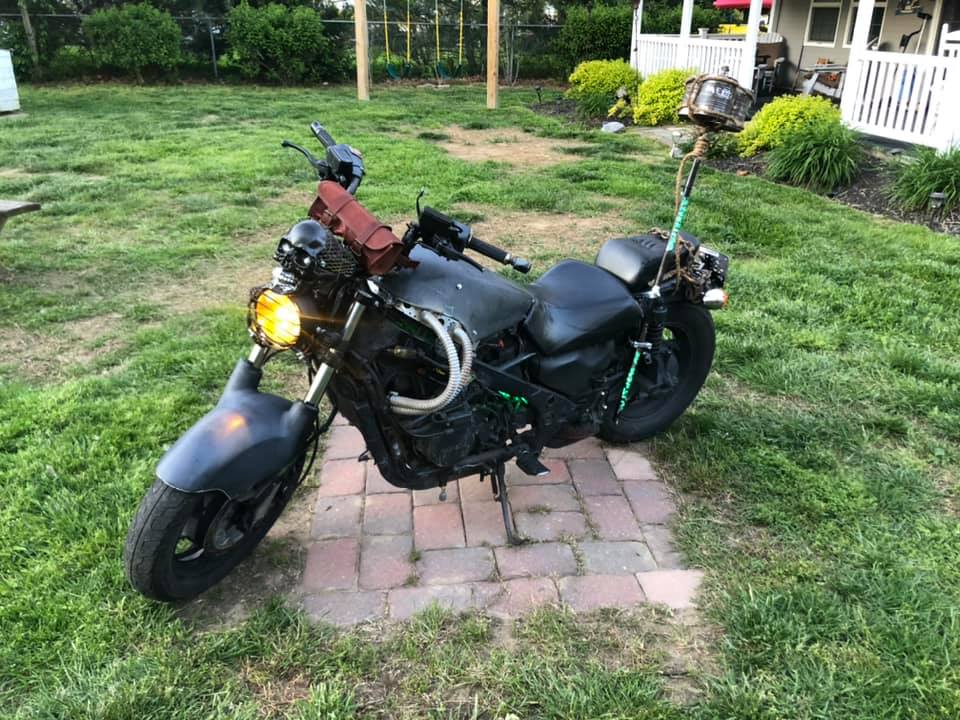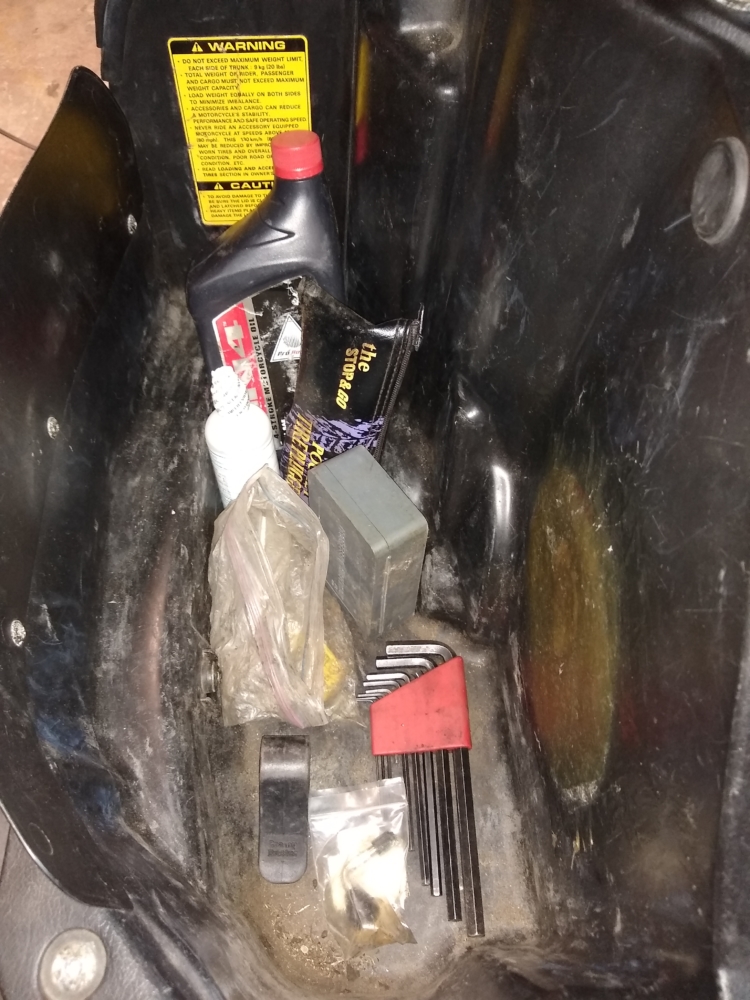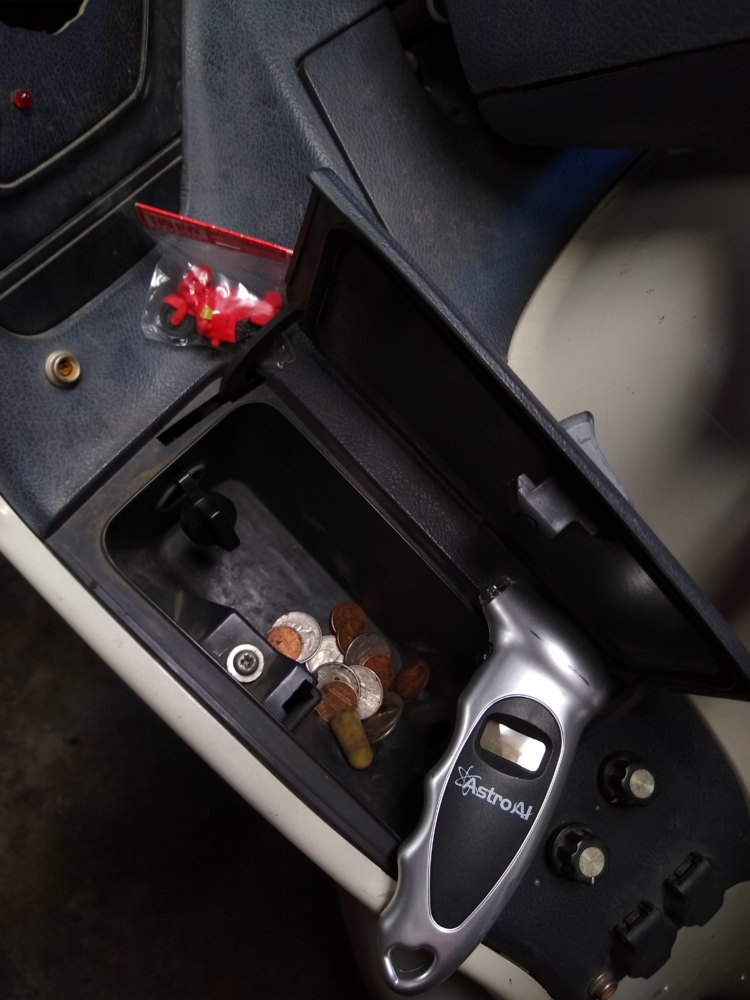This is a list of the model year differences between 1989 and 1998 for the Honda Pacific Coast PC800 motorcycle. While the bikes are largely the same throughout the entire production run, there are some notable visible differences and many smaller mechanical differences that are hidden under the bike’s plastics. This list was developed from a variety of old resources from the iPCRC and elsewhere. A PDF was also compiled at one point with much of this information. Some other information has come from this file but I don’t know who originally put it together.
If you have additional information that should be included here, please email me. This is an ongoing project to catalog model year differences so please do get in touch.

Details of bike serial numbers that we are aware of are available here. Note that while I have tried to capture all of the knowledge on global PC800s, it is possible there is some missing. If so, get in touch!
1989 Model Year
(First year of production)
Number produced: 7698
Upper color: Pearl Pacific White — most of the world — Candy Glory Red available in Italy — Silver available in Japan
Lower color: Ocean Gray Metallic — most of the word — Griffin Gray available in Italy — Dark Gray available in Japan
Seat upholstery: Atlantic Gray with real stitching
Dashboard color: Atlantic Gray
Instrument bezel: Matte Black
Fairing panel/pocket door color: Atlantic Gray
Handlebar plastic covering: Atlantic Gray
Foot kick panel: Black with Silver inlaid strip
ISSUES/CHANGES/NOTES:
- known stator/regulator failure problems
- known left side trunk liner wear-thru problem
- “park” position on ignition switch (1989 only)
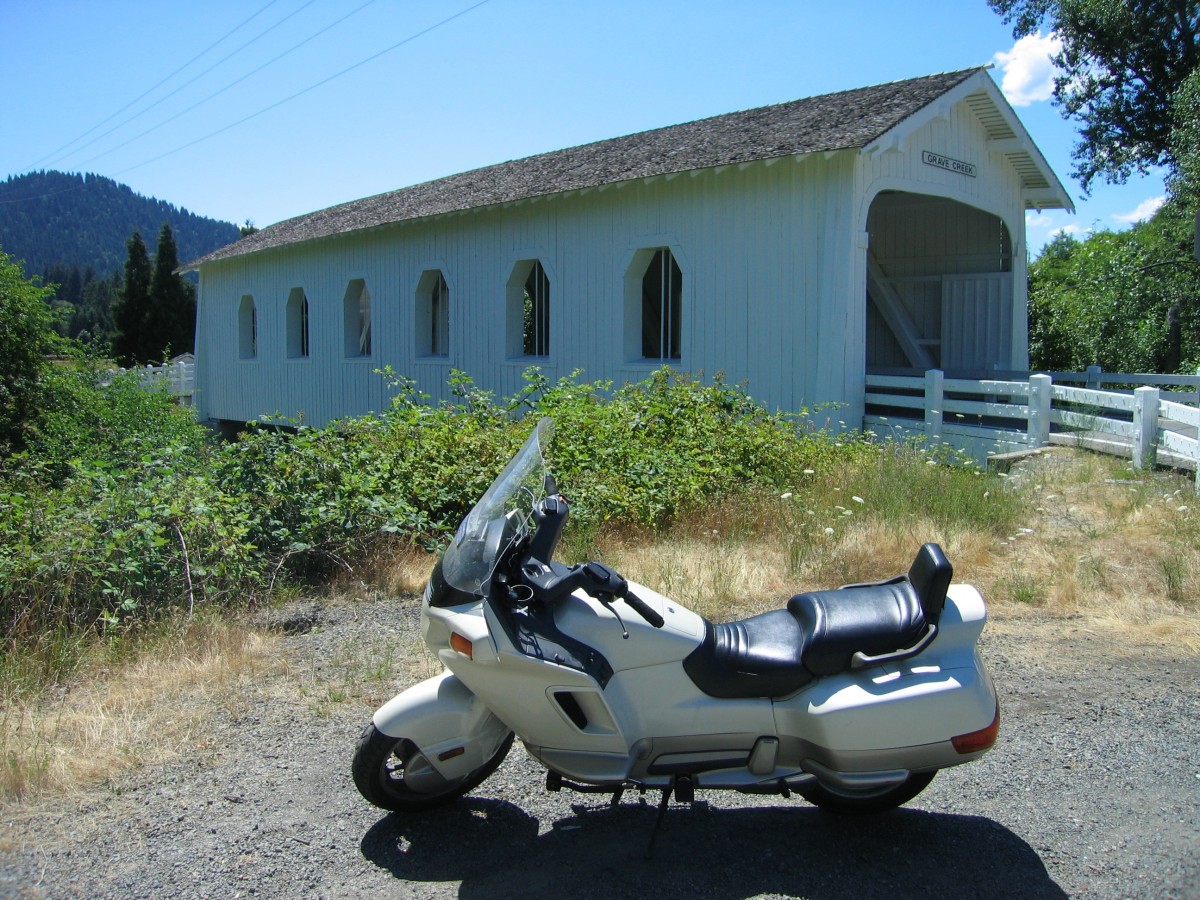
Douglas Van Bossuyt’s 1989 Honda Pacific Coast — “The TARDIS” — visiting a covered bridge in Oregon. 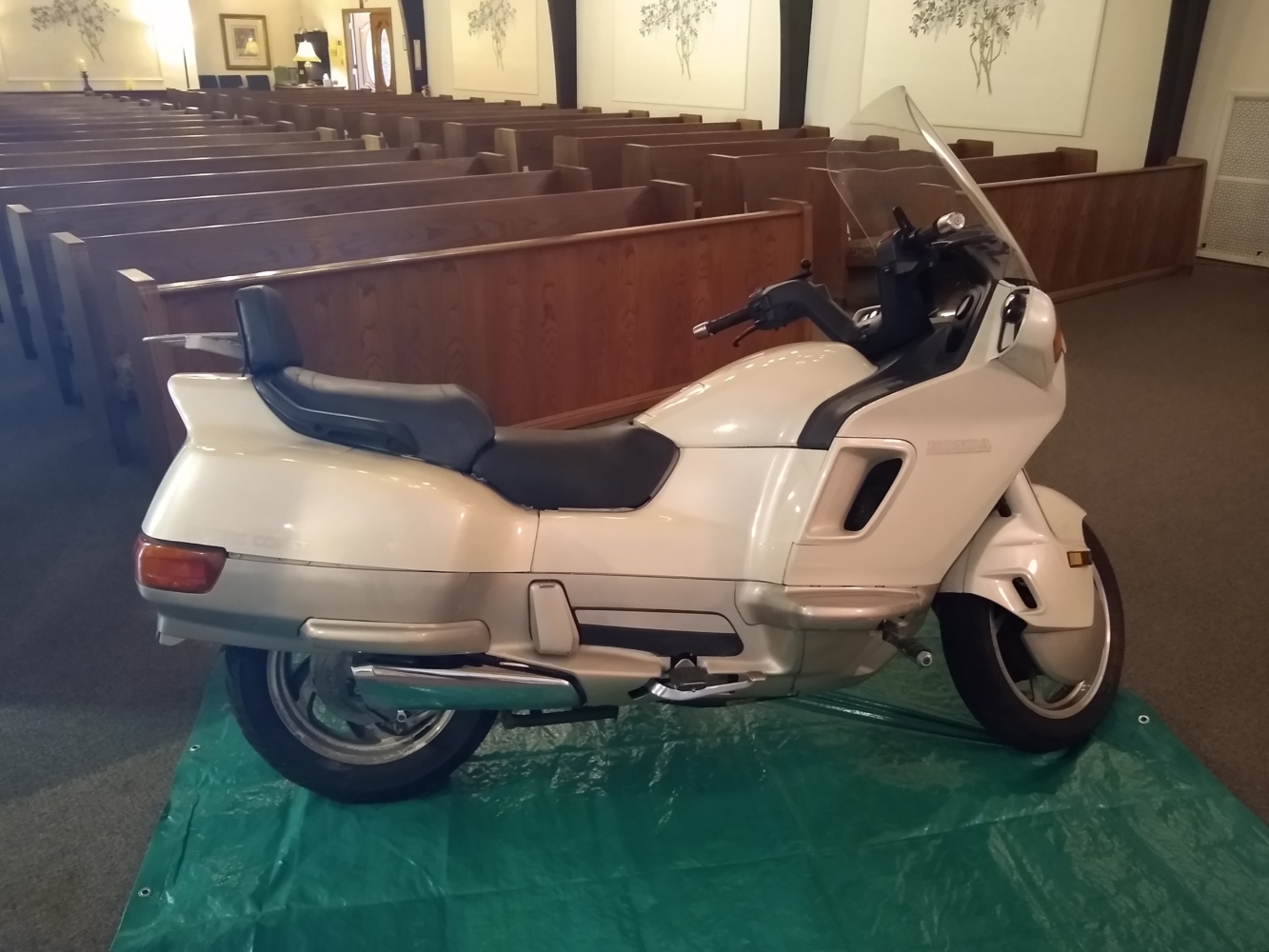
Leland Sheppard’s 1989 Honda Pacific Coast — “Wind Walker” — at Leland’s memorial service. 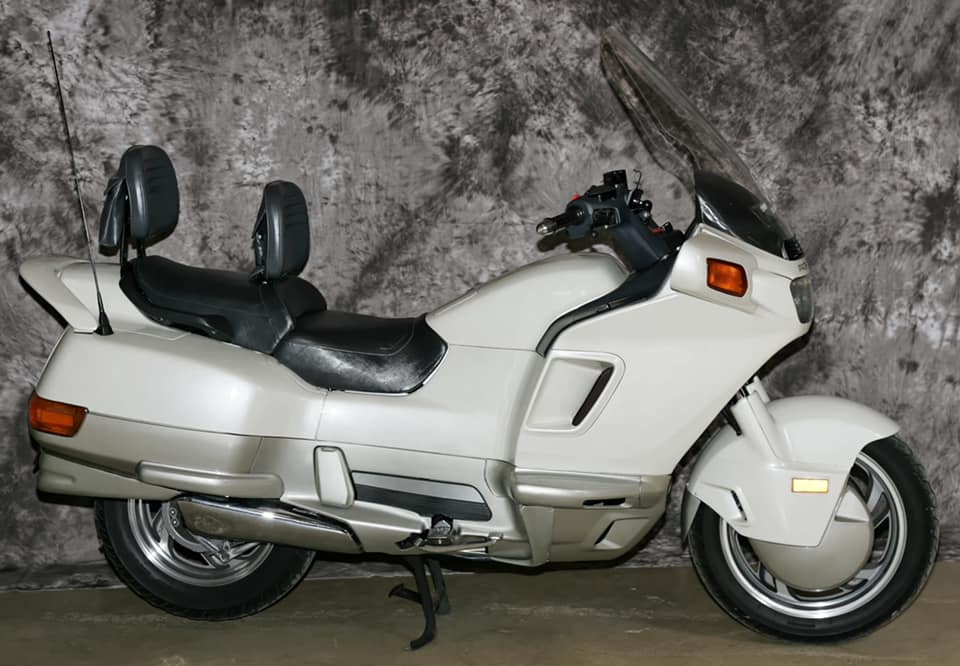
Hervé Vise’s 1989 Honda Pacific Coast.
1990 Model Year
Number produced: 3886
Upper color: Candy Glory Red — most of the world — Light Blue option available in France and Italy
Lower color: Griffin Gray
Seat upholstery: Atlantic Gray with fake stitching
Dashboard color: Atlantic Gray
Instrument bezel: Matte Black
Fairing panel/pocket door color: Atlantic Gray
Handlebar plastic covering: Atlantic Gray
Foot kick panel: black with silver inlaid strip
ISSUES/CHANGES/NOTES:
- approximately 209 changes from 1989, most minor
- slightly larger stock windshield (89 20 1/2” – 90 & up 21 1/4”)
- corrected (or at least improved) the stator failure problem
- corrected the trunk liner wear-thru problem
- added vents to ignition switch cover panel to reduce rider
back pressure - carb jets changed to improve cold weather starting
- sixty-something other changes, mostly fit and finish,
including:- improved tabs so they wouldn’t break so easily
- addition of strap to keep from unlatched coolant fairing cover
from flying off and into the wind while riding
- The 1990 Italian PC800 had a HI/LO/PASSING high beam switch
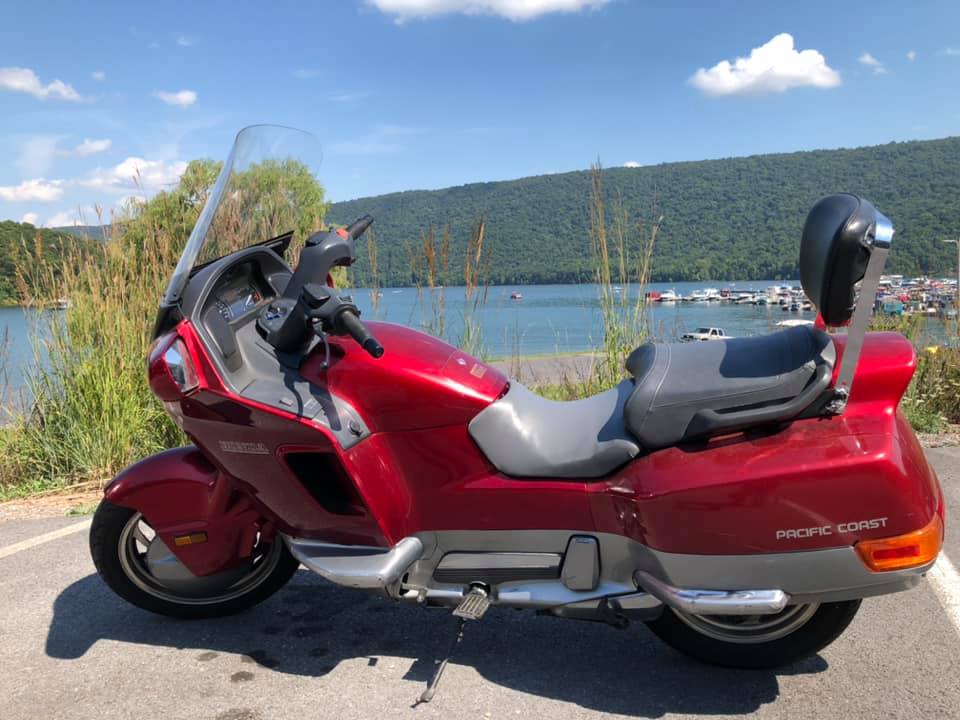
Rich Bowser’s 1990 Honda Pacific Coast with a shaved seat and aftermarket passenger backrest.
1991, 1992, 1993 Model Years
No models produced for these years in Europe or the U.S stated by Honda according to information in January 1994 Rider magazine. There are some bikes in North America, Europe and elsewhere that were sold during these model years from old stock. Generally the VIN or serial number on the bike will answer the question of what year it was really made.
However, there are also reports of there being 1991 and 1993 model year bikes made for Japan. The reports I have are:
Japanese 1991 – Color: Hazy grey metallic (About 400 bikes?)
Japanese 1993 – Color: Black over silver (same as USA 94-95) (About 300 bikes?)
1994 Model Year
(First year of production after 3-year North American break)
Number produced: 1365
Upper color: Black
Lower color: Griffin Gray (same as ’90 lower color)
Seat upholstery: Atlantic Gray with fake stitching
Dashboard color: Atlantic Gray
Instrument bezel: Matte Black
Fairing panel/pocket door color: Atlantic Gray
Handlebar plastic covering: Atlantic Gray
Foot kick panel: Black with Silver inlaid strip
ISSUES/CHANGES/NOTES:
- Reduced number of internal harness/piping clips
- Hondaline radio option no longer offered

Leland Sheppard’s 1994 Honda Pacific Coast — “Black Beauty” — in front of the rest of Leland’s stable of Pacific Coasts.
1995 Model Year
Number produced: 1009
Upper color: Black — most of the world — Hazy Grey Metallic available in Japan
Lower color: Griffin Gray — most of the world — Black available in Japan
Seat upholstery: Atlantic Gray with fake stitching
Dashboard color: Atlantic Gray
Instrument bezel: Matte Black
Fairing panel/pocket door color: Atlantic Gray
Handlebar plastic covering: Atlantic Gray
Foot kick panel: Black with Silver inlaid strip
ISSUES/CHANGES/NOTES:
- This model year is virtually identical to ’94
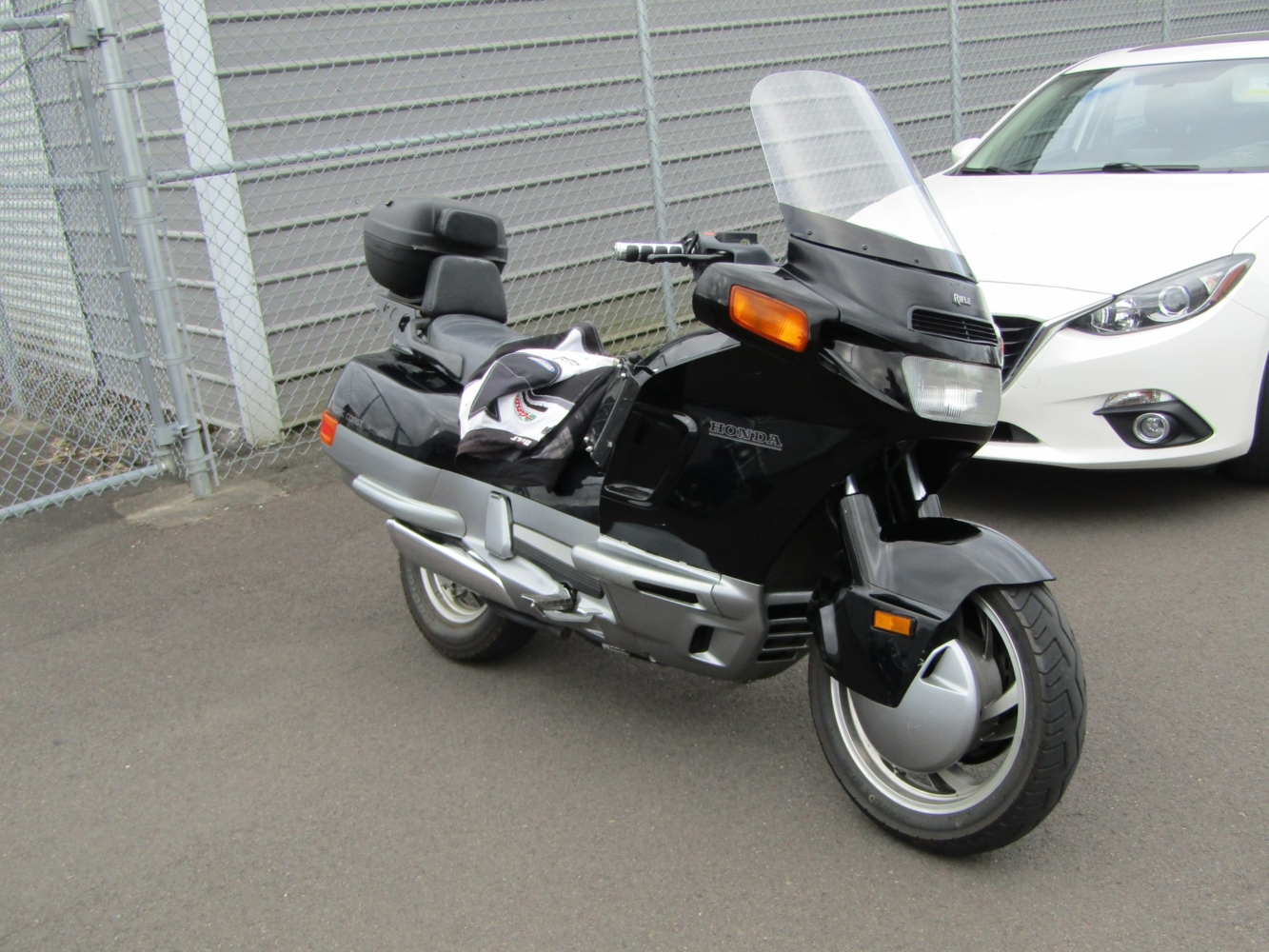
Jerry Stumpf’s 1995 Honda Pacific Coast — “Darkness”
1996 Model Year
Number produced: 1070
Upper color: Magna Red
Lower color: Karakorum Gray
Seat upholstery: Black with fake stitching
Dashboard color: Matte Black
Instrument bezel: Matte Black
Fairing panel/pocket door color: Matte Black
Handlebar plastic covering: Matte Black
Foot kick panel: Black with Silver inlaid strip
ISSUES/CHANGES/NOTES:
- clear coat paint finish dropped starting with this model year. BE CAREFUL with what products you use on the paint!
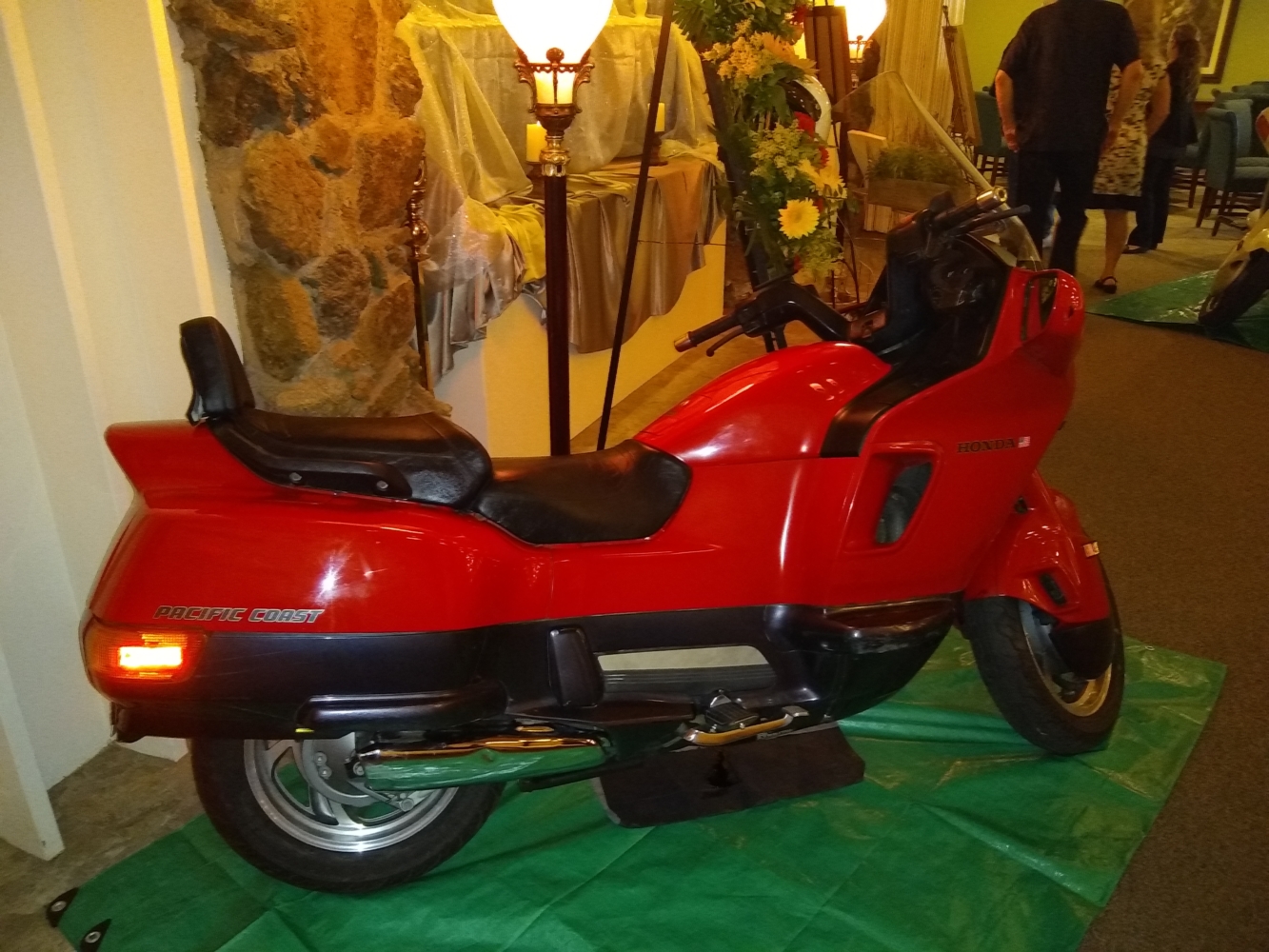
Leland Sheppard’s 1996 Honda Pacific Coast — “Last Chance” — at Leland’s memorial service.
1997 Model Year
(Year of several mfg cost-reduction changes)
Number produced: 0713
Upper color: Magna Red
Lower color: Ostrich Black
Seat upholstery: Black without fake stitching
Dashboard color: Black
Instrument bezel: Black
Handlebar plastic covering: Black
Foot kick panel: Black with Black inlaid strip
ISSUES/CHANGES/NOTES:
- dropped the front rotor covers
- dropped fake chrome exhaust cover on left side
- installed smaller front fender
- dropped self-canceling turn signals
- wind deflector removed from beneath steering head
- rider foot peg mounts painted instead of chrome
- rear brake lever painted instead of chrome
- no clear coat paint finish (same as ’96). BE CAREFUL with what products you use on the paint!
- rear brake arm changed
- fork-leg lowers changed to accommodate the smaller fender
- spare fuse holder in trunk removed. (97 & 98)
1998 Model Year
(Last year of production) $7698 suggested list new
Number produced: 0515
Upper color: Magna Red
Lower color: Ostrich Black
Seat upholstery: Black without fake stitching
Dashboard color: Black
Instrument bezel: Black
Fairing panel/pocket door color: Black
Handlebar plastic covering: Black
Foot kick panel: Black with Black inlaid strip
ISSUES/CHANGES/NOTES:
- This model year is virtually identical to ’97

Michael Conner’s 1998 Honda Pacific Coast loaded up to go do some camping.
Other Relevant Information
- Most changes for a given model year carried through to the following years.
- Detailed part numbers which indicate specific model year changes are available in the parts database.
- All Euro bikes had HEADLAMP ON/OFF switches.
Standard Specs:
| Eng | Bore | Stroke | Disp | Gears | Carburetors | Wheelbase | Seat Height | Fuel Capacity | Warranty | Trunk Capacity |
| V-2 OHC 3 valves/cyl. (2 in 1 exhaust) | 79.5mm | 80.6mm | 800cc | 5 | (2) 36mm Diaphragm CV | 61.2″ (1554.5mm) | 30.1″ (764.5mm) | 4.2 US Gal. (15.9 L) | 12 months / Unlimited miles | Approximately 80L (Left is larger) |
Performance Specs from Various Magazines:
| Testing Magazine | Model Year | HP | Torque | Weight (dry) | Weight (wet) | GVWR | Top Speed | 0-60 mph | 0-100 mph | ET | Trap Speed | Date | Price |
| Online but the source was lost | ?? | 45.6 | 41 | N/A | 620 lb. | N/A | 108 mph | 6.09 sec | N/A | 14.4 | 84.1 mph | July 1997 | $8699 |
| Motorcycle Online | 98 | N/A | N/A | 584 lb. | 640 lb. | N/A | N/A | N/A | N/A | N/A | N/A | N/A | $8699 |
| Cycle Magazine (dyno) | 89 | 51.1 | 43 | N/A | 635 lb. | 988 lb. | N/A | 5.1 sec | N/A | 14.05 | 90.86 mph | June 1989 | $7698 |
| Rider Magazine | 89 | N/A | N/A | N/A | 632 lb. | 988 lb. | N/A | N/A | N/A | N/A | N/A | May 1989 | $7698 |
| Cycle World | 89 | N/A | N/A | N/A | 631 lb. | 988 lb. | 107 mph | 5.6 sec | N/A | 14.48 | 89.35 mph | June 1989 | $7698 |
Cycle magazine did a roll on test from 45mph to 70mph in the May 90 test and got the following:
- Third gear: 4.20 seconds in 355 feet
- Fourth gear: 5.35 seconds in 440 feet
- Fifth gear: 6.80 seconds in 579 feet
- Braking distance was 134 feet from 60 mph
Cycle World Oct 93 test got the following:
- 40 to 60 mph in fifth gear in 5.4 seconds
- 60 to 90 mph in fifth gear in 6.4 seconds
- 30 to zero braking in 28 feet
- Braking distance was 125 feet from 60 mph
MCN (Motorcycle Consumer News) got 60 to zero in 115 feet in 1997
Copies of the test reports were obtained from Ian Smith Information at www.mcreports.com prior to the site dying.
Rick Corwine’s “Coastin’ Down the Coast” article from the June 2001 Rider magazine is included in the reports.
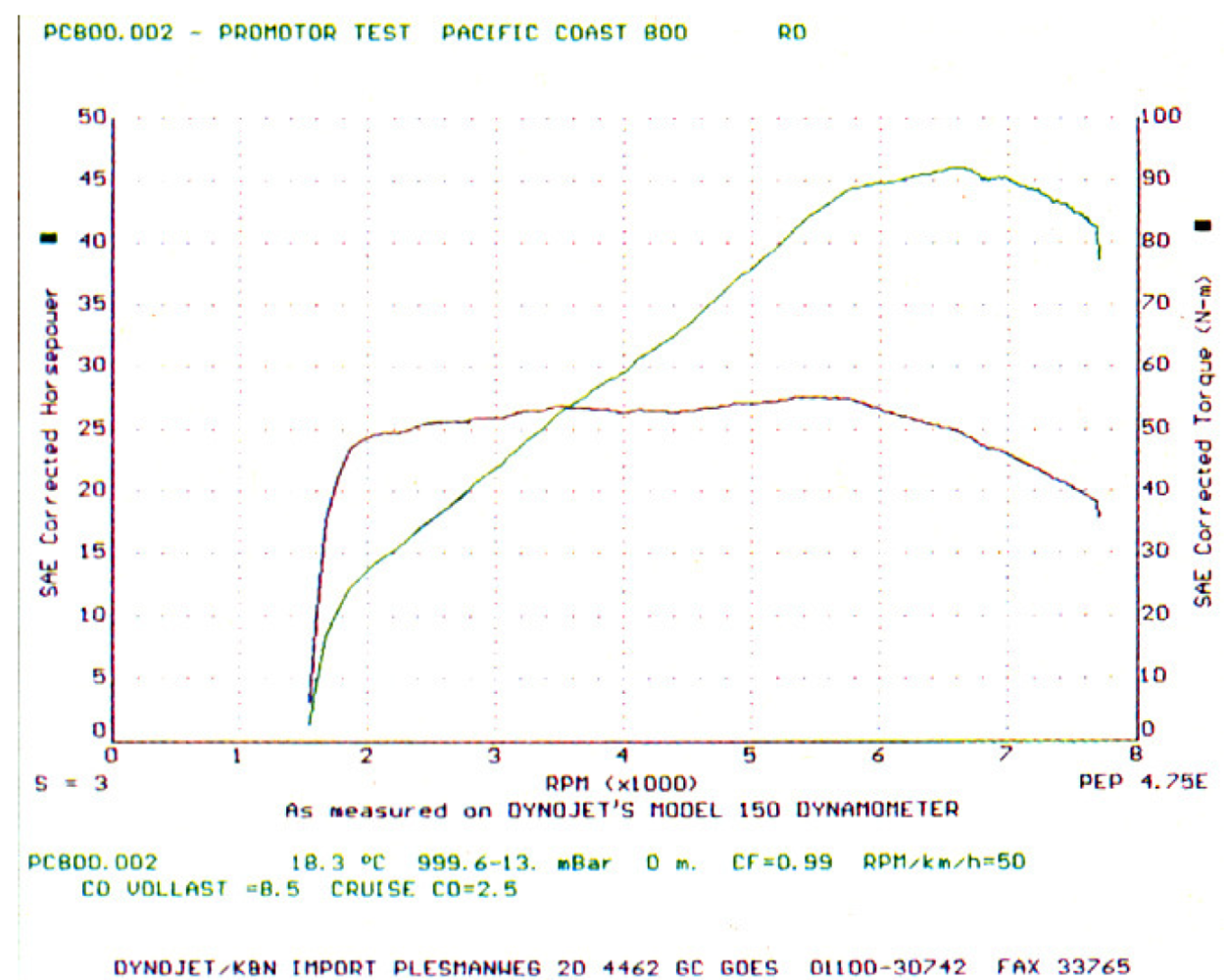
Max power output measured by dynojet on rearwheel: 34.6 kW / 47 hp @ 6600 RPM
Max torque output measured by Honda on crankshaft: 66 Nm @ 5500 RPM
Max torque output measured by dynojet on rearwheel: 55 Nm @ 5500 RPM
Measured CO2 production: 14%
[Editor’s Note: I do NOT know where these dyno figures originally came from or who recorded them. Please let me know if you know who I can credit for these numbers.]
Engine:
- 4 stroke 45 degree 800cc V-twin
- Compression ratio: 9.0 : 1
- Redline on RPM gauge: 7500 RPM
- Rev. limiter: 8000 RPM
- Ratio power/mass: 0.15 kW/kg
- Ignition: Electronic
- Starter: Electric
- Battery capacity: 10 Ah
- Alternator power: 340 W
- Intake system: 2 x Keihin 36 mm CV
- Drivetrain: shaft
- Cooling: liquid
- Gear ratio prim./sec.: 1.811/0.934
- 1st, 2nd, 3rd gear: 2.600/1.700/1.250
- 4th, 5th gearL 0.964/0.800
Bike:
- Length: 2290 mm
- Width: 910 mm
- Height: 1420 mm
- Ground clearance: 140 mm
- Seat height: 785 mm
- Wheelbase: 1555 mm
- Trail: 101 mm
- Rake: 62 degrees
- Travel distance front suspension: 145 mm
- Travel distance rear suspension: 130 mm
- Brand front spring: Showa
- Brand rear spring: Showa
- Tire size front: 120/80-17 61H
- Tire size rear: 140/80-15 M/C 67H
- Brake cylinder type front: 2-piston
- Brake disc diameter front: 276 mm
- Brake drum diameter rear: 180 mm
- Wet weight: 286 kgs
- Max load: 167 kgs
- Ratio weight front/rear: 46/54 %
- Tank volume: 16 liters (incl. 5 reserve)
- Average range: 235 km
Performance:
- Measured gear range:
- 1st: 58 km/h
- 2nd: 88 km/h
- 3rd: 119 km/h
- 4th: 152 km/h
- 5th: 185 km/h (+/-)
- Acceleration 60-80 km/h (5th gear): 4.0 seconds
- Acceleration 80-120 km/h (5th gear): 7.5 seconds
- Measured fuel burn lowest: 5.6 liters/100km
- Measured fuel burn highest: 8.1 liters/100km
- Average fuel burn: 6.4 liters/100km
- Fuel type: Euro-unleaded
- True speed at 50 km/h indicated: 48 km/h
- True speed at 80 km/h indicated: 80 km/h
- True speed at 100 km/h indicated: 99 km/h
- True speed at 120 km/h indicated: 117 km/h
If you have more information that should be included here, please let me know.
